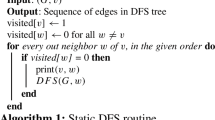Abstract
We analyze the complexity of the restrictions of linear arrangement problems that are obtained if the legal permutations of the nodes are restricted to those that can be obtained by orderings of a binary tree structuring the nodes of the graph, the so-called p-tree. These versions of the linear arrangement problems occur in several places in current circuit layout systems. There the p-tree is the result of a recursive partitioning process of the graph. We show that the MINCUT LINEAR ARRANGEMENT problem and the OPTIMAL LINEAR ARRANGEMENT problem can be solved in polynomial time, if the p-tree is balanced. All other versions of the linear arrangement problems we analyzed are NP-complete.
Zusammenfassung
Wir analysieren die Komplexität von eingeschränkten Linear Arrangement Problemen, bei denen nur solche Permutationen der Knoten erlaubt sind, die durch die Ordnung eines die Knoten des Graphen strukturierenden, binären Baumes — des sogenannten P-tress — entstehen. Derartige Versionen von Linear Arrangement Problemen tauchen an mehreren Stellen in heutigen Schaltkreis Layout Systemen auf. Der P-tree resultiert dabei aus einem rekursiven Zerteiluungsprozeß des Graphen. Wir zeigen, daß das MINCUT LINEAR ARRANGEMENT und das OPTIMAL LINEAR ARRANGEMENT Problem in polynomieller Zeit lösbar sind, wenn der P-tree balanciert ist. Alle anderen betrachteten Versionen von Linear Arrangement Problemen sind NP-vollständig.
Similar content being viewed by others
References
Bui TN, Chauduri S, Leighton FT, Sipser M (1987) Graph bisection algorithms with good average case behaviour. Combinatorica 7/2:171–191
Fellows MR, Langston MA (1988) Layout permutation problems and well-partially-ordered sets. Proc. 5th MIT Conference on Advanced Research in VLSI
Garey MR, Johnson DS (1979) Computers and intractability: a guide to the theory of NP-completeness. Freeman
Kernighan BW, Lin S (1970) An efficient heuristic procedure for partitioning graphs. Bell Sys Tech Journal 49:291–307
Papadimitriou CH (1976) The NP-completeness of the bandwidth minimization problem. Computing 16:263–270
Saxe JB (1980) Dynamic programming algorithms for recognizing small bandwidth graphs in polynomial time. SIAM Journal on Algebraic and Discrete Methods 00:313–369
Shiloach Y (1979) A minimum linear arrangement algorithm for undirected trees. SIAM Journal on Computing 8:15–32
Yannakakis M (1985) A polynomial time algorithm for the mincut linear arrangement of trees. Journal ACM 32:950–959
Author information
Authors and Affiliations
Rights and permissions
About this article
Cite this article
Lengauer, T., Müller, R. Linear arrangement problems on recursively partitioned graphs. Zeitschrift für Operations Research 32, 213–230 (1988). https://doi.org/10.1007/BF01928924
Published:
Issue Date:
DOI: https://doi.org/10.1007/BF01928924




